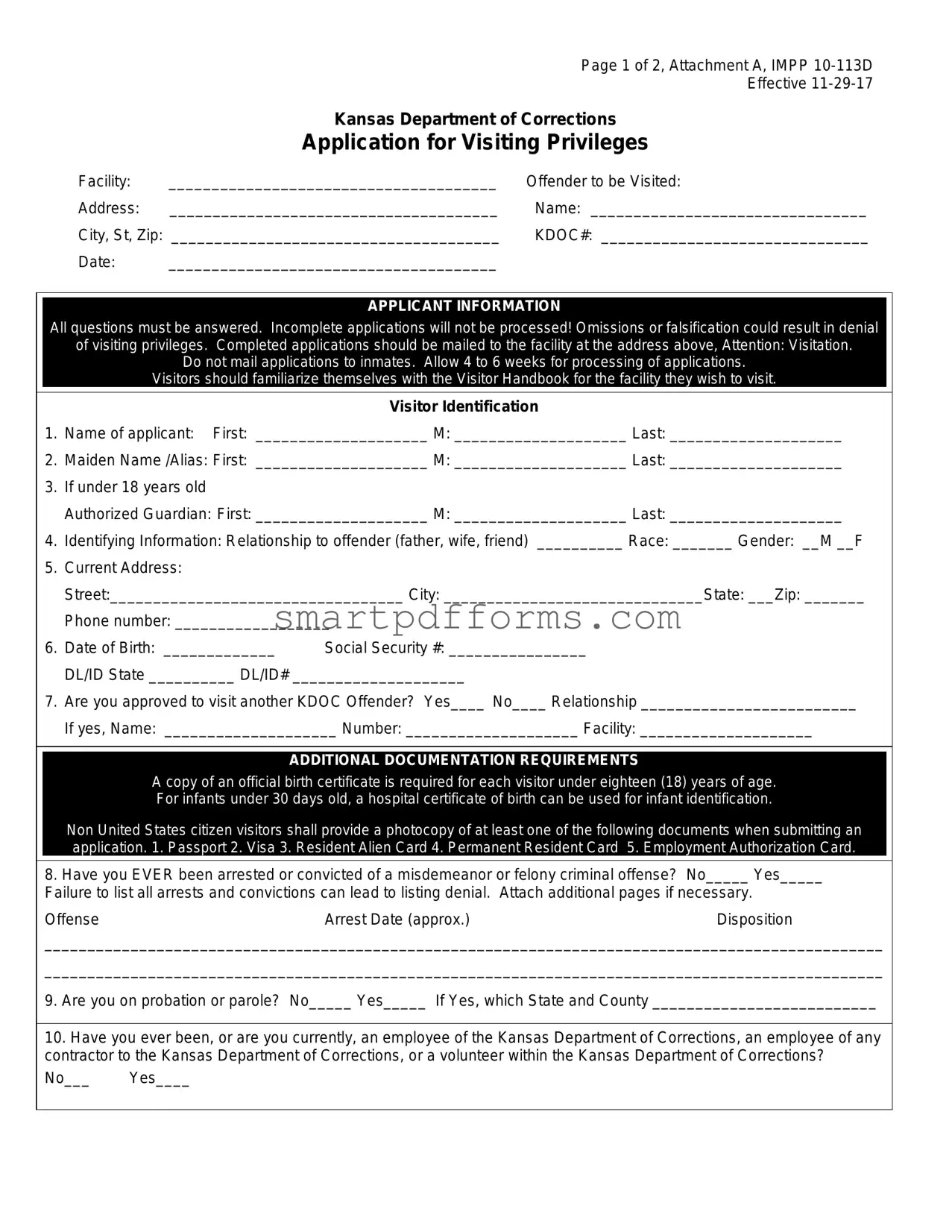|
|
Page 1 of 2, Attachment A, IMPP 10-113D |
|
|
Effective 11-29-17 |
|
Kansas Department of Corrections |
|
Application for Visiting Privileges |
Facility: |
______________________________________ |
Offender to be Visited: |
Address: |
______________________________________ |
Name: ________________________________ |
City, St, Zip: ______________________________________ |
KDOC#: _______________________________ |
Date: |
______________________________________ |
|
APPLICANT INFORMATION
All questions must be answered. Incomplete applications will not be processed! Omissions or falsification could result in denial
of visiting privileges. Completed applications should be mailed to the facility at the address above, Attention: Visitation.
Do not mail applications to inmates. Allow 4 to 6 weeks for processing of applications.
Visitors should familiarize themselves with the Visitor Handbook for the facility they wish to visit.
Visitor Identification
1.Name of applicant: First: ____________________ M: ____________________ Last: ____________________
2.Maiden Name /Alias: First: ____________________ M: ____________________ Last: ____________________
3.If under 18 years old
Authorized Guardian: First: ____________________ M: ____________________ Last: ____________________
4.Identifying Information: Relationship to offender (father, wife, friend) __________ Race: _______ Gender: __M __F
5.Current Address:
Street:__________________________________ City: ______________________________State: ___Zip: _______
Phone number: __________________
6. Date of Birth: _____________ Social Security #: ________________
DL/ID State __________ DL/ID# ____________________
7.Are you approved to visit another KDOC Offender? Yes____ No____ Relationship _________________________
If yes, Name: ____________________ Number: ____________________ Facility: ____________________
ADDITIONAL DOCUMENTATION REQUIREMENTS
A copy of an official birth certificate is required for each visitor under eighteen (18) years of age.
For infants under 30 days old, a hospital certificate of birth can be used for infant identification.
Non United States citizen visitors shall provide a photocopy of at least one of the following documents when submitting an application. 1. Passport 2. Visa 3. Resident Alien Card 4. Permanent Resident Card 5. Employment Authorization Card.
8.Have you EVER been arrested or convicted of a misdemeanor or felony criminal offense? No_____ Yes_____
Failure to list all arrests and convictions can lead to listing denial. Attach additional pages if necessary.
OffenseArrest Date (approx.)Disposition
_________________________________________________________________________________________________
_________________________________________________________________________________________________
9.Are you on probation or parole? No_____ Yes_____ If Yes, which State and County __________________________
10.Have you ever been, or are you currently, an employee of the Kansas Department of Corrections, an employee of any contractor to the Kansas Department of Corrections, or a volunteer within the Kansas Department of Corrections?
No___ Yes____
Page 2 of 2, Attachment A, IMPP 10-113D
Effective 11-29-17
If yes, please provide the details of that past or present employment and volunteer activity:
___________________________________________________________________________________________
___________________________________________________________________________________________
___________________________________________________________________________________________
___________________________________________________________________________________________
11.Were you a victim of the person you wish to visit or were any of your immediate family a victim of the person you wish to visit? No____ Yes _____
(If YES, you must initiate this request through the Department’ Victim Services.) Victim Services can be reached by writing to:
Office of Victim Services
Kansas Department of Corrections
714 SW Jackson, Suite 300
Topeka, KS 66603
or by calling, 1-866-404-6732
WARNING
K.S.A. 21-5914 provides that: (a) Traffic in contraband in a correctional institution or care and treatment facility is, without the
consent of the administrator of the correctional institutional . . . : (1) Introducing or attempting to introduce any item into or upon the grounds of any correctional institution . . . ; (2) taking, sending, attempting to take, or attempting to send any item from any correctional institution or . . . ; (3) any unauthorized possession of any item while in any correctional institution or . . . ; (4) distributing any item while in any correctional institution . . . ; (5) supplying to another who is in lawful custody any object or thing adapted or designed for use in making an escape; or (6) introducing into an institution in which a person is confined any object or thing adapted or designed for use in making any escape. (b) Traffic in contraband in a correction institution . . . is a: (1) Severity level 6, nonperson felony, except as provided in subsection (b)(2) or (b)(3); (2) severity level 5, nonperson if such items are: (A) Firearms, ammunition, explosives or a control substance which is defined in K.S.A. 2016 Supp. 21-5701, and amendments thereto, except as provided in subsection (b)(3); (B) defined as contraband by rules and regulations adopted by the secretary of corrections, in a state correctional institution or facility by an employee of a state correction institution or facility, except as provided in subsection (b)(3); . . . (4)defined as contraband by rules and regulations adopted by the commissioner of the juvenile justice authority, in a juvenile correctional facility by an employee of a juvenile correctional facility, except as provided by subsection (b)(3); and (3) severity level 4, nonperson felony if: (A) Such items are firearms, ammunition or explosives, in a correctional institution by an employee of a correctional institution or in a care and treatment facility by an employee of a care and treatment facility; or (B) a violation of subsection (a)(5) or (a)(6) by an employee or volunteer of the department of corrections or the employee or volunteer of a contractor who is under contract to provide services to the department of corrections. (c) The provisions of subsection (b)(2)(A) shall not apply to the possession of a firearm or ammunition in a parking lot open to the public if the firearm or ammunition is carried on the person while in a vehicle or while securing the firearm or ammunition in the vehicle, or stored out of plain view in a locked but unoccupied vehicle. (d) As used in this section, “correctional institution” means any state correctional institution or facility, conservation camp, state security hospital, juvenile correctional facility, community correction center or facility for detention or confinement, juvenile detention facility or jail.
Effective March 17, 2003, all department facilities, offices, and grounds shall be tobacco-free, at which time all tobacco products shall be declared contraband in accordance with K.S.A. 21-5914 (Traffic in contraband in a correctional institution or care and treatment facility.). On and after this date, the use or possession of all tobacco products by any person is prohibited on department property. The only exception shall be for visitors to secure tobacco and tobacco-based products in their personal motor vehicles in the facility parking lot, unless they are intended for distribution within a facility. Violations of this policy may result in termination of visits, suspension of visiting privileges, and/or possible prosecution.)
Any visitor's possession of a cell phone on the grounds of a correctional facility (except within the confines of his or her vehicle) is prohibited. Violation may result in termination of visits, suspension of visiting privileges, and/or possible prosecution.
Visitor or Visitor’s Guardian
Signature: ___________________________ |
Date: ____________________ |


